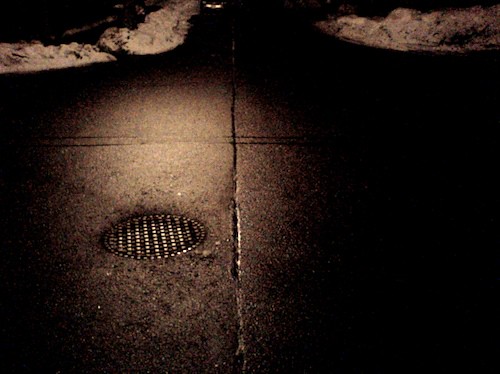
Toronto’s sewers have been in the news lately with the discovery of a crack in a massive trunk pipe buried underneath the Don Valley. Should we appreciate our sewers more or, dare I suggest it, celebrate them? As I wrote in today’s Ideas section of the Toronto Star, appreciation for what gurgles below may not yet match that found in Paris but Toronto is no slouch in both having an impressive subterranean system of our own and a community of people intent on seeing much of it for themselves. Read the rest here.
While California may live with the specter of The Big One waiting to strike at a any moment, Toronto rang in the New Year with headlines that threatened our own catastrophic event: The cracking of a half-century old trunk sewer could potentially fill the Don River with raw sewage. Cynical Torontonians may shrug and say “what’s new?” But that a 2.5-metre-wide pipe silently carrying the waste of 750,000 people to the Ashbridges Bay treatment plant by way of Coxwell Avenue lay buried under the Don Valley all these years — anonymous and unsung — is telling of how much we take our sewers for granted. We only notice them when something goes wrong.
—
The sewage works are no small operations. Ashbridge’s alone serves 1,250,000 people — you can begin to understand how important the Coxwell pipe is — and the sewage takes about 12 hours to flow through the plant. For all our 9,000 kilometres of sewer pipes, including 358 kilometers of trunk collector sewers and eight pumping stations, none get the grand Art Deco treatment that the R.C. Harris water filtration plant got, and Michael Ondaatje has never described any of them as a “Palace of Purification” as he did the Harris. Toronto’s sewers are swept under our psychological rug, like other uncomfortable things. Even elected officials want some distance. When Metro Toronto’s first Chair Frederick “Big Daddy” Gardiner was told an expressway was going to be named after him, Gardiner responded: “They offered to name a sewage plant on the Humber River after me. I said: `No thank you.'”
—
Yet no city has embraced what lies below like Paris has. It’s sewers are celebrated in literature in major works like Les Miserables, a novel that contains this vivid passage: “… Paris has another Paris under herself; a Paris of sewers; which has its streets, its crossings, its squares, its blind alleys, its arteries, and its circulation, which is slime, minus the human form.” During Victor Hugo’s time, sewer tourism was popular. Sewers have slipped into the consciousness of what it means to both be Parisian and to walk through Paris, making it impossible to forget the subterranean network that sustains and maintains the life above.
Photo by kev_walsh.



11 comments
Have you thought about the impact that a failure of this sewer would have on the drinking water in Toronto? Inevitably the sewage would make it way in enormous volumes to the waters around the Toronto Harbour.
The Harris Filtration plant would be unable to process enough water to support much of the demand in Toronto.
This scenario could make Toronto a 3rd world city. Can you say Dysentry? Cholera?
Aw, I wish I had submitted my thinkToronto idea, which was called “Viewports to the Underworld”.
The idea was transparent manhole covers with fog-lighting underneath and included BS such as “The CN Tower not only gives Toronto a sense of orientation but also one of scale of height. This idea proposes putting manhole covers that would expand the limits of our reality by providing a sense of depth” and “Exposing the City’s veins and arteries will reconnect Toronto to its built form and will help reinforce the feeling that this is a living, breathing city.” Ha, maybe that’s why I ended up not submitting it, but it would have been timely in light of this problem.
@ DanT
I doubt that it would have any major impact on our drinking water as our lake water isn’t exactly pristine. The greater concern is sewage infrastructure capacity and local health and environmental problems from all that gushing sewage.
If you are looking for a celebration of the hidden world that lies beneath the streets of Toronto (and other cities for that matter) check out http://www.vanishingpoint.ca. After reading this site I have been a lot more intrigued by what could lay below my feet as I make my way through the city.
Denis> I feature VanishingPoint in the article — click on the link to read the whole thing.
Glorification of sewers is a bit of technological determinism – sewer tourism was possible thanks to the limited construction techniques of the day, and it was popular as sewers were some of the closest available evidence of leading edge technology.
In the 1800s you had to dig tunnels that were human sized. Cut and cover wasn’t an option using muscle power alone, there were no large bore pipes available, and inspection and repair had to be performed by people. All of this led to the vaulted brick tunnels so famous from the arts and tourism.
Now there are very, very few large bore pipes and even fewer that are in any way passable at any time thanks to our improved technology. Full pipes are more sanitary (no vermin scurrying about) and more efficient, so it is only the storm drains that are ever temporarily empty. Storm drains are inherently unsafe to explore, since they fill when it rains, often at a dizzying rate and can have extreme velocities.
It is thus unsurprising that no one is visiting the sewers of Toronto, since they can’t. One can still visit London and Paris’ sewers (or at least the historic parts). Now of course it’s for historical and artistic romanticism rather than the thrill of the new and modern. Toronto’s sewers would have none of that impetus, so the desire would be much less – see boring infrastructure with no redeeming artistic or historical merit, though maybe see where your grandfather’s lawn runoff went.
A bit of actual understanding and logic would be occasionally useful here, instead of attacks on our modern bourgeois life in an attempt to be cool and intellectual. That kind of crap invariably leads to genocide – Vietnam, Cambodia, China, Ukraine, Russia… So get a bloody grip.
Genocide, attacks on bourgeois life — this is by far the greatest comment we have ever got on Spacing. Thank you.
It’s my understanding that when London’s initial sewer system failed due to undersized and poorly made clay pipes, the debate went something like this: “Have you seen the Paris sewers? Are we going to let the French out-engineer the British Empire?!” and as an act of 2 parts bravado and 1 part practicality, the English set out to demonstrate the grandeur of their engineering by making a better sewage system than the French. Their goals were not merely practical but um dare I say it – to glorify the empire. The idea of public works was still a new one and part of their agenda was to see public projects as not just utilitarian but also as monuments. Or maybe I misread Arnold Pacey (The Maze of Ingenuity). At any rate, making our unseen infrastructure a monument to our cleverness is not something you’d ever hear from the City of Toronto.
By the way, my father-in-law told a great story of a metro employee getting the ride of his life (and near death) in a fast flowing storm sewer. Thankfully he was fished out by fast acting co-workers who grabbed him further down the line.
Reality Check’s comment was interesting until he/she got the idea of dissing the idea of “thinking” about our sewer system. And to conclude that Mr. Micallef’s attitude is part of a chain reaction that could, at some point, help lead to genocide, is about the richest thing I’ve read! I had no idea that Maoist were “cool and intellectual”. The irony of a name like “reality check” and his/her comment seems to be lost on them too, I suspect.
And the idea that no one is visiting our sewer system is just plain ignorant: read infiltration or the above mentioned Vanishing point. Lots and lots (and lots) of people are visiting it. Not like Paris, but who wants to be smelly paris.
It seems as though Reality Check and sewers have one thing in common: they’re both full of sh!t. This should be obvious enough to anyone with even a layman’s amount of knowledge regarding a city’s sewer system. He clearly doesn’t know what he’s talking about, especially when he says that older sewers are larger than newer ones.
Also, I wouldn’t say “lots and lots (and lots)” of people are visiting the sewers (and storm drains) in Toronto. As far as I know, there are probably only a half dozen or so “drainers” who are routinely venturing through the underground and seeing things that are in line with what’s shown on http://www.vanishingpoint.ca
Quite true it’s only a few doing it — but that’s all it takes to inject the idea of sewers into a wider imagination. That’s how it works for just about everything — only a few actually do, but they distribute the ideas well enough.
For the record, I’m more than happy to let these few other folks go down in sewers. I’ll just read the romantic reports.